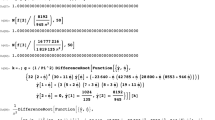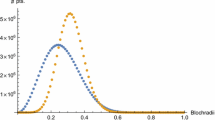Abstract
We employ a quasirandom methodology, recently developed by Martin Roberts, to estimate the separability probabilities, with respect to the Bures (minimal monotone/statistical distinguishability) measure, of generic two-qubit and two-rebit states. This procedure, based on generalized properties of the golden ratio, yielded, in the course of almost seventeen billion iterations (recorded at intervals of five million), two-qubit estimates repeatedly close to nine decimal places to \(\frac{25}{341} =\frac{5^2}{11 \cdot 31} \approx 0.073313783\). However, despite the use of over twenty-three billion iterations, we do not presently perceive an exact value (rational or otherwise) for an estimate of 0.15709623 for the Bures two-rebit separability probability. The Bures qubit–qutrit case—for which Khvedelidze and Rogojin gave an estimate of 0.0014—is analyzed too. The value of \(\frac{1}{715}=\frac{1}{5 \cdot 11 \cdot 13} \approx 0.00139860\) is a well-fitting value to an estimate of 0.00139884. Interesting values \(\big (\frac{16}{12375} =\frac{4^2}{3^2 \cdot 5^3 \cdot 11}\) and \(\frac{625}{109531136}=\frac{5^4}{2^{12} \cdot 11^2 \cdot 13 \cdot 17}\big )\) are conjectured for the Hilbert–Schmidt (HS) and Bures qubit–qudit (\(2 \times 4\)) positive-partial-transpose (PPT)-probabilities. We re-examine, strongly supporting, conjectures that the HS qubit–qutrit and rebit–retrit separability probabilities are \(\frac{27}{1000}=\frac{3^3}{2^3 \cdot 5^3}\) and \(\frac{860}{6561}= \frac{2^2 \cdot 5 \cdot 43}{3^8}\), respectively. Prior studies have demonstrated that the HS two-rebit separability probability is \(\frac{29}{64}\) and strongly pointed to the HS two-qubit counterpart being \(\frac{8}{33}\) and a certain operator monotone one (other than the Bures) being \(1 -\frac{256}{27 \pi ^2}\).









Similar content being viewed by others
References
Lovas, A., Andai, A.: Invariance of separability probability over reduced states in \(4 \times 4\) bipartite systems. J. Phys. A: Math. Theor. 50, 295303 (2017)
Życzkowski, K., Sommers, H.-J.: Hilbert–Schmidt volume of the set of mixed quantum states. J. Phys. A: Math. Gen. 36, 10115 (2003)
Bengtsson, I., Życzkowski, K.: Geometry of Quantum States: An Introduction to Quantum Entanglement. Cambridge University Press, Cambridge (2017)
Caves, C.M., Fuchs, C.A., Rungta, P.: Entanglement of formation of an arbitrary state of two rebits. Found. Phys. Lett. 14(3), 199–212 (2001). https://doi.org/10.1023/A:1012215309321
Slater, P.B.: Master Lovas–Andai and equivalent formulas verifying the \(\frac{8}{33}\) two-qubit Hilbert–Schmidt separability probability and companion rational-valued conjectures. Quantum Inf. Process. 17, 83 (2018)
Khvedelidze, A., Rogojin, I.: On the generation of random ensembles of qubits and qutrits: computing separability probabilities for fixed rank states. In: EPJ Web of Conferences (EDP Sciences), vol. 173 (2018)
Milz, S., Strunz, W.T.: Volumes of conditioned bipartite state spaces. J. Phys. A: Math. Theor. 48, 035306 (2014)
Fei, J., Joynt, R.: Numerical computations of separability probabilities. Rep. Math. Phys. 78, 177 (2016)
Shang, J., Seah, Y.-L., Ng, H.K., Nott, D.J., Englert, B.-G.: Monte Carlo sampling from the quantum state space. I. New J. Phys. 17, 043017 (2015)
Slater, P.B.: A concise formula for generalized two-qubit Hilbert–Schmidt separability probabilities. J. Phys. A: Math. Theor. 46, 445302 (2013)
Slater, P.B., Dunkl, C.F.: Moment-based evidence for simple rational-valued Hilbert–Schmidt generic 2\(\times 2\) separability probabilities. J. Phys. A: Math. Theor. 45, 095305 (2012)
Slater, P.B.: Dyson indices and Hilbert–Schmidt separability functions and probabilities. J. Phys. A: Math. Theor. 40, 14279 (2007)
Slater, P.B.: Extensions of generalized two-qubit separability probability analyses to higher dimensions, additional measures and new methodologies. Quantum Inf. Process. (2018b, to appear). arXiv preprint arXiv:1809.09040
Adler, S.L.: Quaternionic Quantum Mechanics and Quantum Fields, vol. 88. Oxford University Press, Oxford (1995)
Życzkowski, K., Sommers, H.-J.: Induced measures in the space of mixed quantum states. J. Phys. A: Math. Gen. 34, 7111 (2001)
Szarek, S.J., Bengtsson, I., Życzkowski, K.: On the structure of the body of states with positive partial transpose. J. Phys. A: Math. Gen. 39, L119 (2006)
Samuel, J., Shivam, K., Sinha, S.: Lorentzian geometry of qubit entanglement (2018). arXiv preprint arXiv:1801.00611
Avron, J., Kenneth, O.: Entanglement and the geometry of two qubits. Ann. Phys. 324, 470 (2009)
Braga, H., Souza, S., Mizrahi, S.S.: Geometrical meaning of two-qubit entanglement and its symmetries. Phys. Rev. A 81, 042310 (2010)
Gamel, O.: Entangled Bloch spheres: Bloch matrix and two-qubit state space. Phys. Rev. A 93, 062320 (2016)
Jevtic, S., Pusey, M., Jennings, D., Rudolph, T.: Quantum steering ellipsoids. Phys. Rev. Lett. 113, 020402 (2014)
Aubrun, G., Szarek, S.J.: Alice and Bob Meet Banach: The Interface of Asymptotic Geometric Analysis and Quantum Information Theory, vol. 223. American Mathematical Soc, Providence (2017)
Życzkowski, K., Horodecki, P., Sanpera, A., Lewenstein, M.: Volume of the set of separable states. Phys. Rev. A 58, 883 (1998)
Petz, D., Sudár, C.: Geometries of quantum states. J. Math. Phys. 37, 2662 (1996)
Rexiti, M., Felice, D., Mancini, S.: The volume of two-qubit states by information geometry. Entropy 20, ISSN 1099-4300 (2018). http://www.mdpi.com/1099-4300/20/2/146
Singh, R., Kunjwal, R., Simon, R.: Relative volume of separable bipartite states. Phys. Rev. A 89, 022308 (2014)
Batle, J., Abdel-Aty, M.: Geometric approach to the distribution of quantum states in bipartite physical systems. JOSA B 31, 2540 (2014)
Slater, P.B.: Bayesian quantum mechanics. Nature 367, 328 (1994)
Slater, P.B.: Quantum coin-tossing in a Bayesian Jeffreys framework. Phys. Lett. A 206, 66 (1995)
Kwek, L., Oh, C., Wang, X.-B.: Quantum Jeffreys prior for displaced squeezed thermal states. J. Phys. A: Math. Gen. 32, 6613 (1999)
Reconcile a pair of two-qubit boundary-state separability probability analyses. https://physics.stackexchange.com/questions/422887/reconcile-a-pair-of-two-qubit-boundary-state-separability-probability-analyses. Accessed 2018
Slater, P.B.: Formulas for generalized two-qubit separability probabilities. Adv. Math. Phys. 2018, 9365213 (2018)
Slater, P.B.: Exact Bures probabilities that two quantum bits are classically correlated. Eur. Phys. J. B-Condens. Matter Complex Syst. 17, 471 (2000)
Sarkar, A., Kumar, S.: Bures–Hall ensemble: spectral densities and average entropies (2019). arXiv preprint arXiv:1901.09587
Šafránek, D.: Discontinuities of the quantum Fisher information and the Bures metric. Phys. Rev. A 95, 052320 (2017)
Forrester, P.J., Kieburg, M.: Relating the Bures measure to the Cauchy two-matrix model. Commun. Math. Phys. 342, 151 (2016)
Braunstein, S.L., Caves, C.M.: Statistical distance and the geometry of quantum states. Phys. Rev. Lett. 72, 3439 (1994)
Bej, P., Deb, P.: Geometry of quantum state space and entanglement (2018). arXiv preprint arXiv:1805.11292
Dunkl, C.F., Slater, P.B.: Separability probability formulas and their proofs for generalized two-qubit X-matrices endowed with Hilbert–Schmidt and induced measures. Random Matrices Theory Appl. 4, 1550018 (2015)
Penson, K.A., Życzkowski, K.: Product of Ginibre matrices: Fus–Catalan and Raney distributions. Phys. Rev. E 83, 061118 (2011)
Al Osipov, V., Sommers, H.-J., Życzkowski, K.: Random Bures mixed states and the distribution of their purity. J. Phys. A: Math. Theor. 43, 055302 (2010)
Borot, G., Nadal, C.: Purity distribution for generalized random Bures mixed states. J. Phys. A: Math. Theor. 45, 075209 (2012)
Slater, P.B.: A priori probability that two qubits are unentangled. Quantum Inf. Process. 1, 397 (2002)
Slater, P.B.: Silver mean conjectures for 15-dimensional volumes and 14-dimensional hyperareas of the separable two-qubit systems. J. Geom. Phys. 53, 74 (2005)
Leobacher, G., Pillichshammer, F.: Introduction to Quasi-Monte Carlo Integration and Applications. Springer, Berlin (2014)
Livio, M.: The Golden Ratio: The Story of Phi, the World’s Most Astonishing Number. Broadway Books, New York (2008)
The unreasonable effectiveness of quasirandom sequences. http://extremelearning.com.au/unreasonable-effectiveness-of-quasirandom-sequences/. Accessed 2018
How can one generate an open ended sequence of low discrepancy points in 3D? https://math.stackexchange.com/questions/2231391/how-can-one-generate-an-open-ended-sequence-of-low-discrepancy-points-in-3d. Accessed 2018
Devroye, L.: Non-uniform Random Variate Generation. Springer, Berlin (1986)
Can I use compile to speed up inverseCDF? https://mathematica.stackexchange.com/questions/181099/can-i-use-compile-to-speed-up-inversecdf. Accessed 2019
Slater, P.B.: Extended studies of separability functions and probabilities and the relevance of Dyson indices. J. Geom. Phys. 58, 1101 (2008)
Compute a certain ‘separability probability’ via a constrained 4D integration over \([-1,1]^4\). https://mathematica.stackexchange.com/questions/193337/compute-a-certain-separability-probability-via-a-constrained-4d-integration-ov. Accessed 2019
A pair of integrals involving square roots and inverse trigonometric functions over the unit disk. https://mathoverflow.net/questions/325697/a-pair-of-integrals-involving-square-roots-and-inverse-trigonometric-functions-o. Accessed 2019
Approximate/estimate the ratio of two multidimensional constrained integrals. https://mathematica.stackexchange.com/questions/193796/approximate-estimate-the-ratio-of-two-multidimensional-constrained-integrals. Accessed 2019
Ye, D.: On the Bures volume of separable quantum states. J. Math. Phys. 50, 083502 (2009)
Slater, P.B.: Invariance of bipartite separability and PPT-probabilities over Casimir invariants of reduced states. Quantum Inf. Process. 15, 3745 (2016)
Chen, K., Wu, L.-A.: A matrix realignment method for recognizing entanglement. Quant. Inform. Comput. 3(3), 193–202 (2003)
Bae, J., Chruściński, D., Hiesmayr, B.C.: Entanglement witness 2.0: Compressed entanglement witnesses. (2018). arXiv preprint arXiv:1811.09896
Gabdulin, A., Mandilara, A.: Investigating bound entangled two-qutrit states via the best separable approximation. (2019). arXiv preprint arXiv:1906.08963
Xiong, C., Spehner, D., Wu, J.: Geometric quantum discord for two-qubit X-states (2017). arXiv preprint arXiv:1710.04007
Compute the two-fold partial integral, where the three-fold full integral is known. https://mathoverflow.net/questions/322958/compute-the-two-fold-partial-integral-where-the-three-fold-full-integral-is-kno. Accessed 2019
Do these polynomials with harmonic number-related coefficients lie in some particular known class? https://math.stackexchange.com/questions/3115582/do-these-polynomials-with-harmonic-number-related-coefficients-lie-in-some-parti. Accessed 2019
Ozawa, M.: Entanglement measures and the Hilbert–Schmidt distance. Phys. Lett. A 268, 158 (2000)
Sum a certain hypergeometric-function-based expression pertaining to an integration problem. https://mathematica.stackexchange.com/questions/189538/sum-a-certain-hypergeometric-function-based-expression-pertaining-to-an-integrat. Accessed 2019
Tilma, T., Byrd, M., Sudarshan, E.: A parametrization of bipartite systems based on SU (4) Euler angles. J. Phys. A: Math. Gen. 35, 10445 (2002)
Slater, P.B.: Eigenvalues, separability and absolute separability of two-qubit states. J. Geom. Phys. 59, 17 (2009)
Maziero, J.: Random sampling of quantum states: a survey of methods. Braz. J. Phys. 45, 575 (2015)
Can experimental data from a quantum computer be used to test separability probability conjectures? https://quantumcomputing.stackexchange.com/questions/5355/can-experimental-data-from-a-quantum-computer-be-used-to-test-separability-pro. Accessed 2019
Smart, S.E., Schuster, D.I., Mazziotti, D.A.: Experimental data from a quantum computer verifies the generalized Pauli exclusion principle. Commun. Phys. 2, 2 (2019)
Puchała, Z., Miszczak, J.A.: Probability measure generated by the superfidelity. J. Phys. A: Math. Theor. 44, 405301 (2011)
Zyczkowski, K., Slomczynski, W.: The Monge metric on the sphere and geometry of quantum states. J. Phys. A: Math. Gen. 34, 6689 (2001)
Slater, P.B.: Quantum and Fisher information from the Husimi and related distributions. J. Math. Phys. 47, 022104 (2006)
Rexiti, M., Felice, D., Mancini, S.: The volume of two-qubit states by information geometry. Entropy 20, 146 (2018)
Acknowledgements
This research was supported by the National Science Foundation under Grant No. NSF PHY-1748958.
Author information
Authors and Affiliations
Corresponding author
Additional information
Publisher's Note
Springer Nature remains neutral with regard to jurisdictional claims in published maps and institutional affiliations.
Rights and permissions
About this article
Cite this article
Slater, P.B. Numerical and exact analyses of Bures and Hilbert–Schmidt separability and PPT probabilities. Quantum Inf Process 18, 312 (2019). https://doi.org/10.1007/s11128-019-2431-2
Received:
Accepted:
Published:
DOI: https://doi.org/10.1007/s11128-019-2431-2




